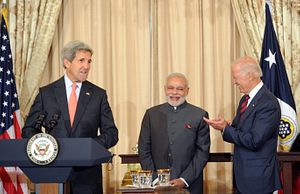It’s been a good month for trade talks with India. On November 14, U.S. Trade Representative Michael Froman announced that a four-month impasse with India concerning food security and the World Trade Organization (WTO) Bali trade facilitation agreement had been broken. A U.S.-India “agreement on trade faciliation” should at last allow the WTO Bali package to advance. It’s most welcome news, especially since India’s refusal to ratify the Bali agreement back in July had resulted in an existential crisis for the WTO. As Froman stated in his speech to Indian industry, “Some have suggested that the India-U.S. breakthroughs—in Bali and again two weeks ago—may well have saved the multilateral trading system.”
On the heels of that progress, Froman traveled to India for a long-overdue (by some four years) meeting of the U.S.-India Trade Policy Forum (TPF). The TPF just completed its sessions, and the joint statement released today suggests positive momentum on the ever-difficult agricultural trade matters. A new technical group will work on issues like food safety, along with plant and animal health. India and the United States also agreed to increase conversation on services and investment, where a great deal of two-way trade already occurs—and not surprisingly, where substantial disagreements have also surfaced. Manufacturing trade and intellectual property also received specific mention, and the joint statement notes agreement to intensify consultation on both.
That’s all good news, because on November 21, 2014, Prime Minister Narendra Modi tweeted an invitation to President Barack Obama to visit as India’s official guest for Republic Day on January 26. In a span of an hour—all on Twitter—President Obama (via the NSC Press Twitter handle) accepted. This means the U.S. and Indian bureaucracies have about eight weeks to prepare another summit-level program effectively on the heels of Modi’s visit to Washington that just took place at the end of September. Both governments will need to work overtime to complete preparations—and trade and investment matters will be a boon to the visit if some ambitious goals can be realized.
A summit-level meeting will need some accomplishments, or “deliverables,” to announce. After a very rocky couple years on economic matters, November’s trade accomplishments—in the category of overcoming problems—offer scope to move ahead with more visionary targets. Here I would urge the United States government to take a vocal and public stand endorsing India’s candidacy as the next member in the Asia Pacific Economic Cooperation Forum (APEC). I’ve written about this before, and continue to believe that the size of India’s economy along with the importance of India’s economic growth for Asia more broadly makes it uniquely well suited for APEC membership. With a trade-focused prime minister at the helm in New Delhi, there’s no better time to respond to his government’s focus on economic growth by supporting Indian entry into APEC. As a non-binding forum, but one focused on commitments toward free and open trade, APEC membership for India could also provide a mechanism to help bridge some of the difficult trade disagreements still at issue in the U.S.-India bilateral relationship.
Of course, we are already too late to be the first mover on getting India into APEC. China, this year’s APEC summit host, stepped ahead in July by offering an unprecedented invitationto Prime Minister Modi to attend the summit. Modi was not able to do so in the end, but the gesture of the invitation implicitly endorsed India’s candidacy for membership. Washington should coordinate with New Delhi on the next appropriate diplomatic steps to get APEC membership on the agenda quickly and acted upon at the next summit next November, when the Philippines will host.
The last time President Obama visited India, he endorsed Indian permanent membership “on a reformed UN Security Council.” APEC membership hardly seems as contentious nor as difficult to achieve—but it would have an immediate and positive impact.
Alyssa Ayres is Senior Fellow for India, Pakistan, and South Asia at the Council on Foreign Relations. She blogs at Asia Unbound. This post appears courtesy of CFR.org and Forbes Asia.

































